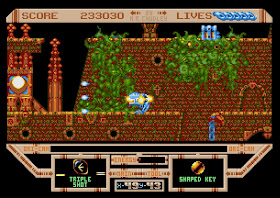M.U.S.H.A. is a vertically scrolling shoot ‘em
up released exclusively for the Sega
Mega Drive
It’s the year 2290 AD and man is advanced enough to start
colonising outer space. However, the
supercomputer controlling a colony goes rogue and starts sending its attack
units against mankind (very original).
You are one of a squad of pilots sent to put a stop to the attack. Unfortunately all your wingmen are shot down
and it is left to you to fight on alone.
The game has you clad in the flying Metallic Uniframe Super Hybrid Armour of the title. This ‘armour’ doesn’t provide any protection
as you lose a life with one hit. If you
die you reappear in the same spot with no let up in the onslaught. The default weapon is a single forward firing
laser. In line with the genre, M.U.S.H.A. is played over several
stages (seven in all), each concluding with a boss fight.
Your longevity and firepower are greatly improved by picking
up the secondary weapons/power-ups that frequently appear. They are displayed as Lightning, Fire and
Water symbols. The Lightning and Fire
power-ups improve your firepower, while the Water icon provides a rotating defensive
shield. You can only carry one type of power-up
at a time, but it can be upgraded up to four times if you continue to collect the
same icon. They also provide some
protection as if you are hit you lose the power-up before losing a life. Strangely, the main and secondary weapons are
mapped to different buttons so I had to hold down both for maximum effect.
Firepower can also be increased by collecting the chips
dropped by a particular craft that occasionally hovers on the screen. As well as upgrading your main weapon, the
chips provide a maximum of two bullet firing drones - three chips for each
drone. Continuing to collect the chips
when you already have two drones creates replacements that are available if one
is destroyed.
You can cycle through several formations for the drones depending
on the situation. ‘Forward’ supplements your main weapon. With '3Way' they fire forward and slightly to the side. 'Back' fires backwards. Select 'Reverse' and they fire in the opposite way to which you are moving (the same as the red pods in Image Fight). If you choose ‘Roll’ they circle your
ship firing outwards in all directions. In ‘Free’
mode, the drones home in on enemies and pelt them with bullets until they are
destroyed.
Finally, you can also change your speed but only when the
game is paused.
M.U.S.H.A. is intense, non-stop action with
lots of bullets and varied enemies filling the screen. Additionally, the scrolling is smooth and
fast with no hint of slowdown when the screen gets busy. The music is also good and gets the
adrenaline pumping nicely. Although very
fast, the game is not overly difficult due to the fact the power-ups provide
limited protection and you respawn in the same spot when you die. M.U.S.H.A.
is a game I like a lot and proves that first impressions don’t mean a thing.
Example gameplay - NB. Uploading the file to YouTube caused glitches in the graphics making the ship and weapons disappear. Also the scrolling is not as smooth.









